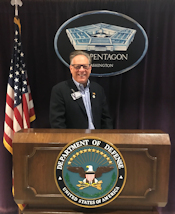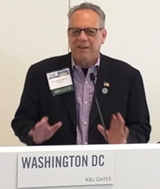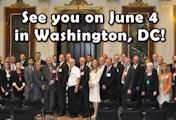NanoBusiness Alliance Interview – Lynn L. Bergeson, Managing Director, Bergeson & Campbell, P.C.
Posted on December 13th, 2010 | No Comments »
The NanoBusiness Alliance is very committed to providing relevant Environmental, Health and Safety information to our Nanotechnology Community. Today, we continue our interview series with Lynn L. Bergeson, Managing Director, Bergeson & Campbell, P.C. (B&C). Lynn is one of America’s top EH&S practitioners and is the Chairman of the NanoBusiness Alliance’s EHS Committee. B&C is a Washington, D.C. law firm concentrating on conventional and engineered nanoscale chemical, pesticide, and other specialty chemical product approval, regulation, litigation, and associated business issues. Ms. Bergeson is also Principal of The Acta Group, L.L.C. and The Acta Group EU, Ltd, B&C’s consulting affiliates, with offices in Washington, D.C. and Manchester, U.K., respectively. Ms. Bergeson counsels clients on a wide range of issues pertaining to chemical hazard, exposure and risk assessment, risk communication, and related legal and regulatory aspects of conventional and nanoscale chemical regulatory programs under the Federal Insecticide, Fungicide, and Rodenticide Act (FIFRA), the Toxic Substances Control Act (TSCA), the Registration, Evaluation, Authorization and Restriction of Chemicals (REACH) regulation, and on issues pertinent to nanotechnology and other emerging transformative technologies.
Ms. Bergeson lectures and writes frequently on a wide range of chemical regulatory matters. She serves on the Editorial Board of Nanotechnology Law and Business, 2008–; Press Advisory Board of Environmental Law Institute’s (ELI) Environmental Law Reporter, 2007–; Editorial Board of ELI’s The Environmental Forum, 2004–; Pesticide & Toxic Chemical News, 2002–; EPA Administrative Law Reporter, 1996–; Environmental Quality Management, 2002–; Chemical Processing Magazine, 2002–; and Pollution Engineering, 1990–, among other publications. Ms. Bergeson is a member of The District of Columbia Bar; Bar Association of the District of Columbia; American Bar Association (Section of Environment, Energy, and Resources); Women’s Bar Association of the District of Columbia; and the Women’s Council on Energy and the Environment. Ms. Bergeson is a graduate of Michigan State University (B.A., magna cum laude), and the Columbus School of Law, Catholic University of America, where she was a member of the Law Review. She is admitted to the bar of the District of Columbia and several federal circuit courts.
In this interview, we speak with Lynn about a wide range of issues related to nanotech Environmental, Health and Safety (EHS). We hope you enjoy the interview. – Steve Waite
SW: It is a pleasure speaking with you today, Lynn. There has been a lot of work in nanotech EHS over the past decade. What are the major things we have learned?
LB: Steve, thank you for speaking with me. We have learned quite a lot. First, we know that nanotechnology covers a dazzling array of technologies that are applicable to a similarly broad range of industry sectors. We know these applications are beneficial, and require nurturing. We know also that much work remains to be done to ensure consumer confidence and demonstrate effective regulatory and governance oversight.
SW: What are the hot nano EHS topics today?
LB: There are several big issues. The most global, and vexing, has to do with defining terms. Establishing a nano nomenclature that is uniform, thoughtful, and useful for regulatory purposes is a priority. This is especially true given the growing number of regulatory initiatives that are emerging in the U.S., European Union (EU), and elsewhere. Here in the U.S., the U.S. Environmental Protection Agency’s (EPA) Office of Pollution Prevention and Toxics (OPPT) is working on three Toxic Substances Control Act (TSCA) proposals that will have an immediate and significant impact on the commercialization of nanoscale materials. These are a Section 4 request for testing, a Section 5 categorical significant new use rule (SNUR), and a Section 8 request for information. EPA’s Office of Pesticide Programs (OPP) is also working on a policy under the Federal Insecticide, Fungicide, and Rodenticide Act (FIFRA) that will apply to nanopesticides. If issued, it too will have a significant impact on nanoscale materials used in pesticide products.
SW: EHS testing has become more difficult over the years with greater restrictions on using animals and humans for tests. How are companies coping with these restrictions?
LB: Companies with which I work appreciate the limitations on animal testing and the growing restrictions on testing involving humans. That said, in vivo testing will continue to be necessary if we are to develop credible scientific evidence that helps identify with precision the circumstances and types of materials that might pose risks. While there are a growing number of alternative testing methodologies and strategies that nanomaterial manufacturers and related others may use to demonstrate the safety and efficacy of their nano innovations, these alternatives are in their infancy. For example, in vitro tests are used with bulk materials to predict toxicity to humans. Such tests must be carefully calibrated to be useful, and the utility and limitations of such testing must be known to ensure test results are meaningful.
SW: Let’s talk about the various regulatory agencies for a moment. What are the major EHS initiatives at the EPA currently?
LB: As noted, EPA is most active in regulating new nanoscale chemical substances under TSCA. EPA has reviewed over 100 nanoscale substances and has obtained a solid and growing knowledge of a range of nanoscale materials. EPA is now working on TSCA Sections 4, 5, and 8 rulemakings. EPA’s pesticide office is less far along, and is focusing on nanoscale materials used in biocide applications. EPA is developing an “interpretation” of FIFRA Section 6(a)(2) (adverse effects) reporting pertinent to nanoscale materials known to be included in pesticide products, and reportedly working on FIFRA Section 3 data call-ins for certain substances. All of these initiatives are important.
At the state level, all eyes are on California. The Department of Toxic Substances Control’s (DTSC) data call-ins on nanoscale materials are important developments as are the Office of Environmental Health Hazard Assessment (OEHHA) Green Chemistry Hazard Traits Endpoints and DTSC’s implementation of the Green Chemistry Initiative as these developments relate to nanoscale materials.
SW: What are the significant EHS initiatives at the FDA today?
LB: The U.S. Food and Drug Administration (FDA) seem to be moving very deliberately. The Task Force it set up made a number of recommendations in 2007 that the Agency is still discussing in various public venues and fora such as the public meeting it held on September 23, 2010, to obtain information and opinions on characterization, manufacturing, and biocompatibility of nanomaterials. FDA is using such information, and the results of testing it conducts in Arkansas and that the Nanotechnology Characterization Laboratory of the National Cancer Institute (NCI) conducts in Maryland in large part to answer the basic regulatory question it must first address: When is a nanomaterial the “same” as its macro-particle counterpart? The answer to that question will have a big impact on the classification of products and will determine the standards a manufacturer must meet to obtain approval or clearance, as well as the data to support submissions for that purpose, for types of products, including generic drugs, indirect food additives, food contact substances, dietary new ingredients, and substantially equivalent medical devices. Where the issue is not a claim that the material is the “same” as in a predicate product, FDA will have to decide the proof needed to meet the applicable regulatory standard for that class of product, and it is doing so, to date, on an ad hoc basis, rather than by regulation or guidance.
SW: What are the major nanotech EHS initiatives we are seeing currently in the EU?
LB: In the EU, the European Chemicals Agency’s (ECHA) ongoing work under the Registration, Evaluation, Authorization and Restriction of Chemicals (REACH), in particular the REACH Implementation Projects (RIP) on nanomaterials, is important in the regulation of nanoscale materials, as is developing guidance under the Classification, Labeling, and Packaging regulation, EC No. 1272/2008. Finally, the EU implementation of the food and cosmetics labeling regulation is important, and will have precedent setting implications.
SW: Are we seeing greater collaboration among the various regulatory authorities inside and outside the U.S. with respect to nanotech EHS?
LB: Yes. Domestically, federal agencies coordinate through the National Nanotechnology Initiative (NNI) under the management framework of the National Science and Technology Council (NSTC). The Nanoscale Science Engineering and Technology (NSET) Subcommittee of the NSTC coordinates planning, budgeting, and program implementation. In addition, the White House Policy Coordination Group is a policy committee that was formed to address “emergent technologies,” including nanotechnology. This group also coordinates across federal agencies. Finally, there are agency-specific groups embedded in specific federal agencies, including EPA and FDA, focused on ensuring consistency within federal agencies.
Internationally, the Organization for Economic Cooperation and Development (OECD) has been devoted to fostering harmony on multiple issues pertinent to nanotechnology. The Working Party on Manufactured Nanomaterials and Working Party on Nanotechnology were created several years ago and are devoted to developing a shared view on technical and policy issues, and leveraging internal resources in a way that maximizes OECD member countries’ and others’ investments in nanotechnology.
SW: What are the typical kinds of mistakes companies make with regard to nanotech EHS?
LB: Nano companies are in many respects no different than other more traditional businesses. Prudent business planning and effective product stewardship goes a long way. A commitment to be responsible and compliant with all applicable laws and regulations is also a must. Importantly, however, nano businesses must grow and flourish in a fluid regulatory context where standards and courses of business conduct are evolving. This definitional and regulatory fluidity invites uncertainty that is typically unnerving to management, investors, insurers, and business owners. As a business owner, I can relate and sympathize. It is all the more reason companies need to plan smart, get really good legal counsel, and monitor evolving domestic and international regulations and business standards carefully.
One of the benefits of NanoBusiness Alliance membership is being kept aware of these evolving standards and practices, and being offered an opportunity to discuss the cutting edge business issues that are of concern and interest to the nano industry, and the business strategies most likely to be successful in a challenging economy.
SW: What companies are at the forefront of nanotech EHS today?
LB: That is a hard question to answer as there are many companies contributing greatly to nano EHS excellence today. Certainly, DuPont is to be commended for its collaboration with the Environmental Defense Fund in creating the Nano Risk Framework, http://www.nanoriskframework.com, which is the premier framework for ensuring the responsible development of nanotechnology. I reference DuPont by name as its development of this useful business tool has helped immeasurably in promoting nano EHS. There are many, many other companies, large and small, as well as entities, public and private, that have contributed greatly, too numerous to note by name. Government entities are also to be commended. In particular, EPA’s New Chemicals Division staff and leadership, Jim Willis, Jim Alwood, and Kristan Markey, to name a few; NNI leadership, Clayton Teague; and National Institute for Occupational Safety and Health (NIOSH), Chuck Gerasi, have all made valuable contributions to promoting the responsible development of nanotechnology.
SW: What can the nanotech community learn from other industries’ experience with EHS?
LB: Perhaps the most important lesson is to innovate with a view toward considering the life cycle consequences of product design and to communicate regularly and often with all stakeholders. Nanotechnology offers tremendous promise as a pollution prevention tool. Its benefits must be advocated relentlessly. All too often the areas of uncertainty regarding potential risk posed by unbound nanoscale materials eclipses other aspects of nano innovations. Nano stakeholders and business people need to be able to make the case that nano innovations are designed and engineered to be better, more efficient, and more benign than their macro counterparts, and to be able to demonstrate these features at all stages of the product’s life cycle. Nano stakeholders must also commit to a higher level of transparency in their business dealings, and more robust outreach and education to ensure the public is aware of the promise of nanotechnology, and embraces it, and understands the benefits and manageable risks of nanotechnology as any other emerging technology. To the extent the genetically modified organisms (GMO) experience has taught us anything, it is that public confidence is an essential element in the calculus of achieving success. That a company, or an industry for that matter, is selling a shiny new widget that is the next “it” means nothing if the public does not buy it. I have faith in human nature and believe fundamentally that people “get” nano, but industry must accept its role as an advocate for the technology and relentlessly educate and steward the technology properly to ensure its growth, and redouble efforts to ensure the highest standards of EHS excellence.
SW: For companies that need assistance with EHS issues, what kinds of services does your firm provide to the nanotech community?
LB: We offer a wide variety of services to the nanotech community, and are uniquely qualified to do so. B&C professionals have long worked with EPA’s OPPT staff on TSCA Inventory and nomenclature issues. We work with clients on precisely these matters and on EPA’s evolving TSCA regulatory framework, as it relates to nanomaterials and nanostructures that consist of chemical substances.
Importantly, and as innovators know, new chemical substances, including those manufactured at the nanoscale, must be reviewed by EPA. An important part of our practice is assisting innovators wishing to commercialize their nano innovations by working with EPA scientists and regulators in meeting their compliance obligations under TSCA. Similarly, nanopesticides and inerts must be reviewed by EPA’s OPP under FIFRA. We assist clients in preparing for this review, and in compiling FIFRA registration applications.
We have also actively participated in the initial efforts of several offices within FDA to assess the effect nanotechnologies may have on the data requirements for different FDA approvals and clearances. B&C co-hosted with the Office of Food Additive Safety (OFAS) a meeting to discuss whether and how nanotechnologies might impact guidances issued by OFAS regarding the chemical and toxicological data needed to support a food contact notification. We also monitor how the use of nanotechnologies in drug delivery systems may affect the already complicated jurisdictional issues faced when a product contains both a drug and device component. The Office of Combination Products within FDA must sort out these issues, as well as determine the extent to which different components of FDA become involved in the review of drug delivery systems. We will seek to ensure that issues of nanotechnologies are considered in their proper context by FDA, as it develops a comprehensive policy on the regulation of products produced employing nanotechnologies.
Similarly, B&C has significant experience in counseling clients and conducting advocacy initiatives with the National Toxicology Program (NTP) and has worked for years with scientists inside and outside of NTP on science policy issues involving testing protocols, the development of analytical methods, and related topics. B&C represents many companies and trade organizations that have disputed, or are in the process of disputing, the findings of an NTP study. Our assistance in this regard has consisted of marshaling the technical resources necessary to launch a comprehensive review of the findings, drafting the advocacy documents necessary to support such an effort, and representing our clients in discussions with NTP staff. Given NTP’s current research initiatives involving nanoscale materials, this experience is invaluable.
We also work closely with companies and chemical testing consortia to ensure that NTP’s selection of chemicals, protocols used once a chemical has been nominated for chemical testing, and the technical conclusions and inferences drawn from the test results are presented in a fair and technically defensible way. B&C offers clients an NTP tracking system that advises clients of the status of NTP’s chemical testing initiatives with respect to particular chemical compounds. This tracking system allows companies an opportunity proactively to participate in the chemical testing process. Doing so helps blunt the possibility for erroneous test results, and hence minimizes the possibility that ill-conceived conclusions will be drawn with respect to test chemicals.
B&C routinely counsels clients on a wide variety of matters under the Occupational Safety and Health Act. B&C professionals have also long worked with NIOSH on a wide range of issues addressing workplace safety. We assist clients in developing compliance plans and business protocols that successfully meet their obligations under occupational safety and health laws, and related employee-protection standards.
Finally, we assist clients with a variety of business needs – supply agreements, insurance coverage issues, hazard communication and labeling needs, and a whole range of other business needs.
SW: Thanks again for your time, Lynn. We appreciate your insights on nanotech EHS and wish your firm all the best.
Regards,
Vincent Caprio “Serving the Nanotechnology Community for Over a Decade”
Executive Director
NanoBusiness Alliance
203-733-1949
vincentcaprio@nynanobusiness.org
www.nynanobusiness.org
www.vincentcaprio.org




